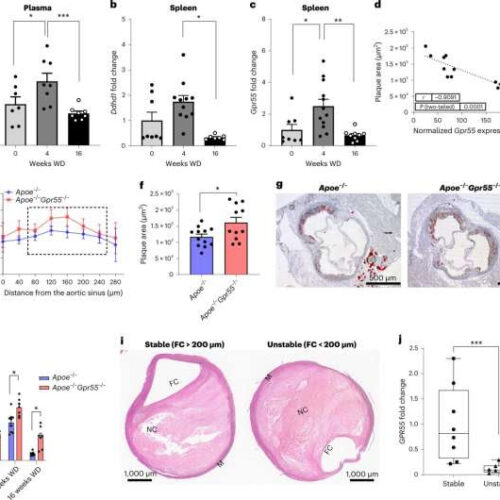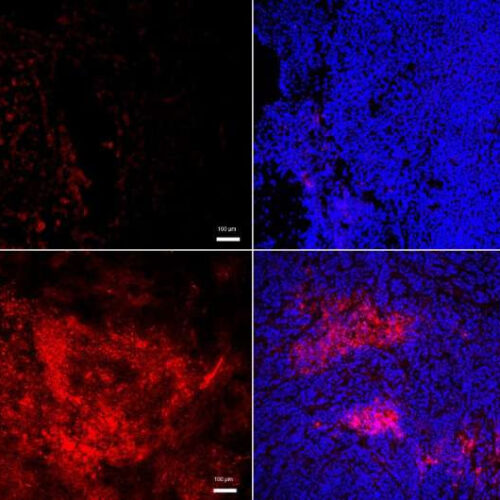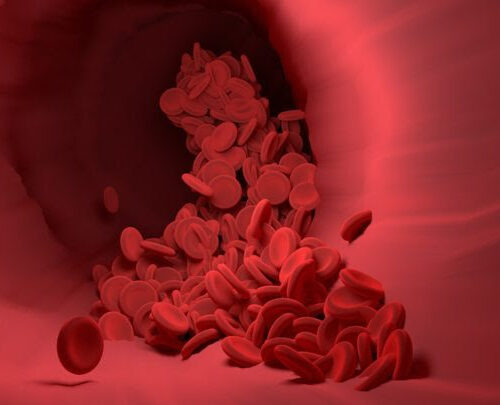by American Heart Association Credit: CC0 Public Domain Sleeping an inconsistent number of hours each night and falling asleep at different times may increase the risk of developing atherosclerosis among adults older than 45 compared to people with more consistent sleep habits, according to new research published today in the Journal of the American Heart Association....
Tag: <span>atherosclerosis</span>
Atherosclerosis: How the body controls the activity of B cells
by Ludwig Maximilian University of Munich Regulation and function of GPR55 signaling in atherosclerosis. a–d, Plasma, spleens and aortic roots were collected from Apoe−/− mice at baseline or after 4 weeks and 16 weeks of WD to determine LPI plasma concentrations (n = 7–8; *P = 0.05 and ***P = 0.0042) (a) or relative splenic mRNA expression of the gene encoding the LPI-synthesizing enzyme...
A common mechanism for cancer metastasis and atherosclerosis
by Hokkaido University Oxidized-LDL accumulates (left column) in malignant tumors (bottom) much more than in non-malignant ones (top). This attracts neutrophils (right column, red) to malignant tumors (bottom), but not to non-malignant ones. Credit: Takuya Tsumita, et al. International Journal of Cancer. May 24, 2022 A key molecule for cancer metastasis has been identified as a molecule...
Researchers discover more about what causes atherosclerosis
by Ingebjørg Hestvik, Norwegian University of Science and Technology Why does inflammation occur in the blood vessels? Nathalie Niyonzima is one of the researchers who has uncovered an important cause. Credit: Ingebjørg Hestvik The underlying cause of many cardiovascular diseases is inflammation of the artery walls. Now NTNU researchers have found that a specific neurotransmitter...
The Xa Factor: pushing back on Atherosclerosis
TOKYO MEDICAL AND DENTAL UNIVERSITY VIDEO: THE XA FACTOR: PUSHING BACK ON ATHEROSCLEROSIS CREDIT: ASSOCIATE PROFESSOR YASUHIRO MAEJIMA, TMDU New research by a team led by researchers from the Department of Cardiovascular Medicine at Tokyo Medical and Dental University (TMDU); and the Department of Cardiovascular Medicine at Tokyo Kyosai Hospital has opened up interesting pathway...
New discovery on how omega-3 fatty acids can reduce atherosclerosis
A receptor activated by substances formed from omega-3 fatty acids plays a vital role in preventing inflammation in blood vessels and reducing atherosclerosis, a new study from Karolinska Institutet published in The Journal of Clinical Investigation reports. The discovery can pave the way for new strategies for treating and preventing cardiovascular disease using omega-3 fatty...
Antioxidants to Prevent LDL Oxidation Act to Restore Macrophage Function and Reverse Atherosclerosis in Mice
Researchers here demonstrate that introducing an antioxidant into the diet, one that accumulates in cell lysosomes, helps to prevent macrophage dysfunction and thus reverse atherosclerotic plaque in an animal model of atherosclerosis. The hypothesis is that oxidized LDL particles, ingested and carried to lysosomes for degradation, are an important component of dysfunction in the macrophage cells...
Cardiovascular disease: Atherosclerosis and the immune system
Medical researchers at LMU have uncovered how signal proteins of the immune system regulate the development of atherosclerosis. Image credit: Pixabay (Free Pixabay license) Atherosclerosis is one of the most common causes of death in Germany. The condition is characterized by the build-up of cholesterol and other fatty metabolites in the arterial wall directly below the endothelial...
Can knowledge about brown bears contribute to development of a vaccine against atherosclerosis in humans?
High blood lipids and inactivity are two risk factors for atherosclerosis in humans. When the European brown bear (Ursus arctos) hibernates during winter, it is inactive for 5-6 months and also develops high blood lipids, but still, shows no signs of atherosclerosis. European brown bear. Image credit: Alexas_fotos via Pixabay, free license Professor Johan Frostegård´s...
PPARα Slows Atherosclerosis by Inhibiting Vascular Cellular Senescence
It may turn out to be the case that many mechanisms of cellular regulation that slow aspects of aging function, at least in part, by slowing the pace at which senescent cells accumulate. Senescent cells induce tissue dysfunction via inflammatory signaling. Studies in which senescent cells are selectively destroyed in old tissues via senolytic drugs have resulted in...









